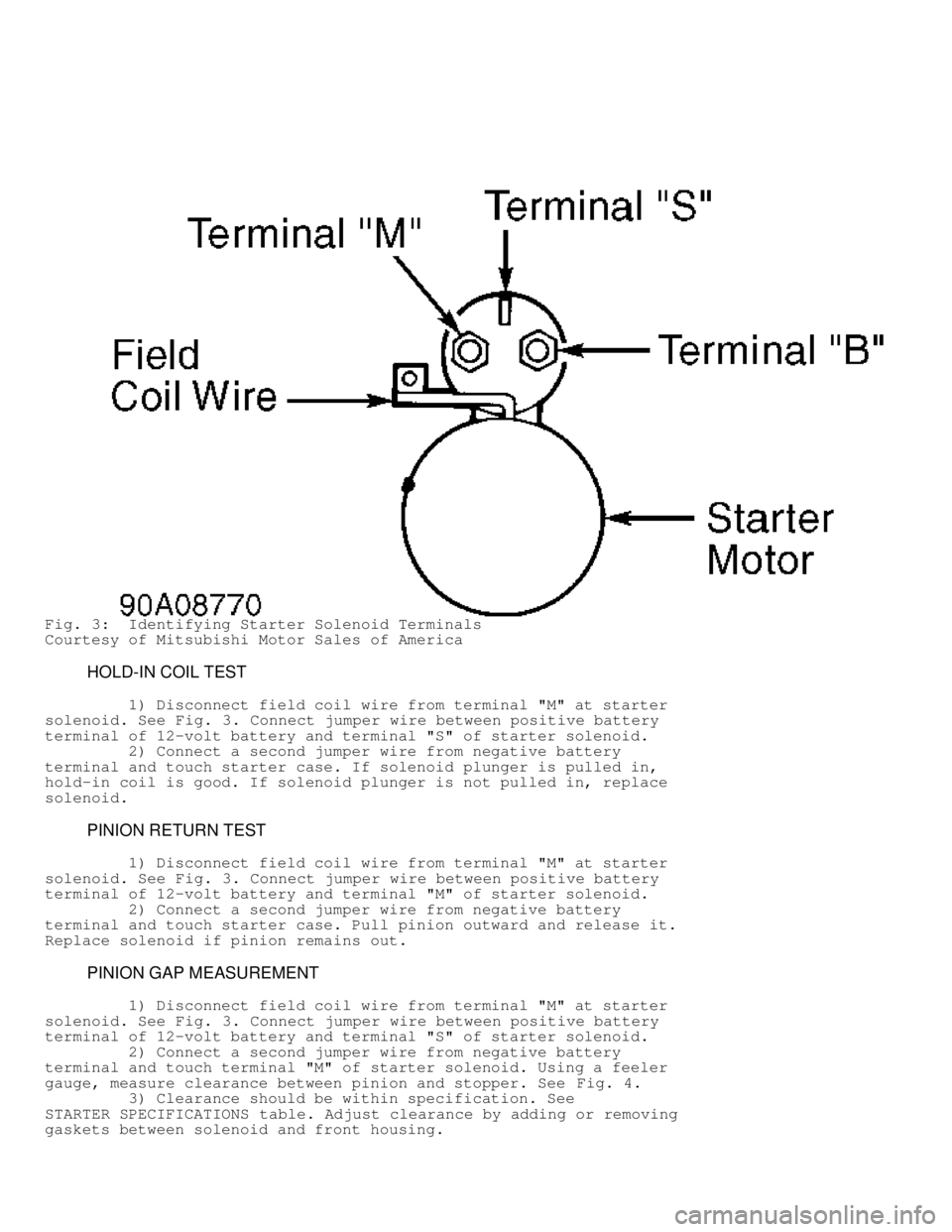adding oil MITSUBISHI MONTERO 1998 Service Manual
[x] Cancel search | Manufacturer: MITSUBISHI, Model Year: 1998, Model line: MONTERO, Model: MITSUBISHI MONTERO 1998Pages: 1501, PDF Size: 25.81 MB
Page 104 of 1501

Other Means Of Identification
Refrigerant R-134a, when viewed through a sight glass, may
have a "milky" appearance due to the mixture of refrigerant and
lubricating oil. As the refrigerant and oil DO NOT exhibit a "clear"
sight glass on a properly charged A/C system, most R-134a systems have
no sight glass.
REFRIGERANT OILS
NOTE: Use ONLY the specified oil for the appropriate system or A/C
compressor. Always check vehicle underhood A/C specification
label or A/C compressor label before adding refrigerant oil
to A/C compressor/system. See Figs. 2 and 3. Always use
refrigerant oil specified on vehicle underhood A/C
specification label if different from the following list.
Refrigerant R-12 based systems use mineral oil, while R-134a
systems use Polyalkylene Glycol (PAG) oils. Using a mineral oil based
lubricant with R-134a will result in A/C compressor failure due to
lack of proper lubrication. The following R-134a refrigerant oils are
currently specified:
Use DENSO/ND-Oil 8 refrigerant oil on Nippondenso
compressors. Use SUN PAG 56 refrigerant oil on Sanden compressors.
NOTE: PAG oils absorb moisture very rapidly, 2.3-5.6 percent by
weight, as compared to a mineral oil absorption rate of
0.005 percent by weight.
SERVICE EQUIPMENT
A/C systems using R-134a refrigerant and PAG lubricants
cannot use R-12 refrigerant or mineral oil lubricants. R-134a
refrigerant is NOT compatible or interchangeable with R-12
refrigerant. Separate sets of hoses, manifold gauge sets and
recovery/recycling equipment are required to service the different
systems. This is necessary to avoid cross-contaminating and damaging
A/C system. A single set of A/C service equipment cannot be cleaned
thoroughly enough to be used with both types of refrigerant.
All equipment used to service A/C systems using R-134a must
be U.L. listed and certified to meet SAE standard J2210. The service
hoses on the manifold gauge set must have manual (turn wheel) or
automatic back-flow valves at the service port connector ends. This
will prevent refrigerant from being released into the atmosphere.
For identification purposes, R-134a service hoses must have a
Black stripe along its length and be clearly labeled SAE J2196/R-134a.
The low pressure test hose is Blue with a Black stripe. The high
pressure test hose is Red with a Black stripe, and the center test
hose is Yellow with a Black stripe.
R-134a manifold gauge sets can be identified by one or all of
the following: Labeled FOR USE WITH R-134a on set, labeled HFC-134a or
R-134a on gauge face, or by a Light Blue color on gauge face. In
addition, pressure/temperature scales on R-134a gauge sets are
different from R-12 manifold gauge sets.
SYSTEM SERVICE VALVES
SCHRADER-TYPE VALVES
NOTE: Although similar in construction and operation to a tire
valve, NEVER replace a Schrader-type valve with a tire valve.
Page 968 of 1501

allowing metal objects to contact the battery posts and the
vehicle at the same time.
CAUTION: Never disconnect the battery while the engine is running;
doing so could damage the car's electrical components.
REPLACING BLOWN FUSES
Before replacing a blown fuse, remove ignition key, turn off
all lights and accessories to avoid damaging the electrical system. Be
sure to use fuse with the correct indicated amperage rating. The use
of an incorrect amperage rating fuse may result in a dangerous
electrical system overload.
BRAKE PAD WEAR INDICATOR
Indicator will cause a squealing or scraping noise, warning
that brake pads need replacement.
BRAKE FLUID
WARNING: DO NOT use reclaimed fluid or fluid that has been stored
in old or open containers. It is essential that foreign
particles and other liquids are kept out of the brake fluid
reservoir.
CATALYTIC CONVERTER
Continued operation of vehicle with a severe malfunction
could cause converter to overheat, resulting in possible damage to
converter and vehicle.
ENGINE COOLANT SERVICE
WARNING: To avoid the danger of being scalded never change the coolant
when the engine is hot.
WARNING: Never remove the radiator cap when the engine is hot Serious
burns could be caused by high pressure fluid escaping from
the radiator.
CAUTION: When adding or replacing engine coolant, use a high quality
ethylene glycol antifreeze diluted with 50% distilled water.
When putting the cap on the reserve tank, line up the arrow
on the cap and the arrow on the tank, or coolant can leak out
ENGINE DRIVE BELT SERVICE
WARNING: Be sure the ignition key is OFF. The engine could rotate
unexpectedly.
ENGINE OIL
WARNING: The engine oil may be high enough to burn your fingers
when the drain plug is loosened. Wait until the drain plug
is cool enough to touch with you bare hands.
WARNING: Continuous contact with used engine oil has been found to
cause skin cancer in laboratory animals. Brief contact with
used engine oil may irritate skin. To minimize your exposure
to used oil, wear a long sleeve shirt and moisture-proof
gloves when changing oil. If oil contacts your skin, wash
Page 1085 of 1501

Fig. 3: Identifying Starter Solenoid Terminals
Courtesy of Mitsubishi Motor Sales of America
HOLD-IN COIL TEST
1) Disconnect field coil wire from terminal "M" at starter
solenoid. See Fig. 3. Connect jumper wire between positive battery
terminal of 12-volt battery and terminal "S" of starter solenoid.
2) Connect a second jumper wire from negative battery
terminal and touch starter case. If solenoid plunger is pulled in,
hold-in coil is good. If solenoid plunger is not pulled in, replace
solenoid.
PINION RETURN TEST
1) Disconnect field coil wire from terminal "M" at starter
solenoid. See Fig. 3. Connect jumper wire between positive battery
terminal of 12-volt battery and terminal "M" of starter solenoid.
2) Connect a second jumper wire from negative battery
terminal and touch starter case. Pull pinion outward and release it.
Replace solenoid if pinion remains out.
PINION GAP MEASUREMENT
1) Disconnect field coil wire from terminal "M" at starter
solenoid. See Fig. 3. Connect jumper wire between positive battery
terminal of 12-volt battery and terminal "S" of starter solenoid.
2) Connect a second jumper wire from negative battery
terminal and touch terminal "M" of starter solenoid. Using a feeler
gauge, measure clearance between pinion and stopper. See Fig. 4.
3) Clearance should be within specification. See
STARTER SPECIFICATIONS table. Adjust clearance by adding or removing
gaskets between solenoid and front housing.